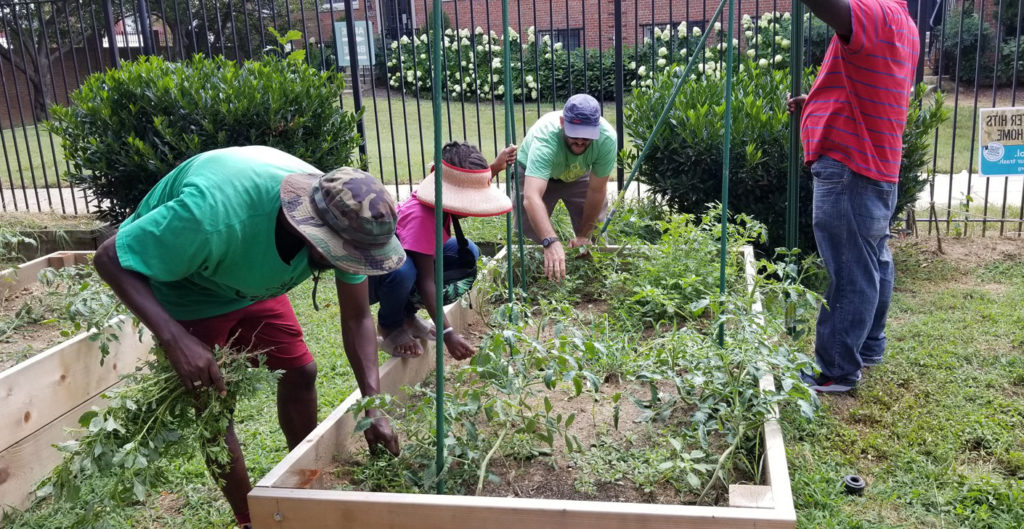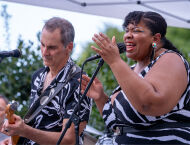Eat
 Photo: courtesy of Healthy Living, Inc.
Photo: courtesy of Healthy Living, Inc.
DC’s Champions of Healthy Eating
October 4, 2019 @ 12:00am
DC wasn’t always a place for folks looking to eat healthy. For some living in the city, it still isn’t. For example, in Southeast DC, there is still an utter lack of grocery stores – even with the announcement of new additions earlier this year. Low-income and at-risk residents often lack the resources and education to make healthy decisions with regards to food. Add that to scarcity, and the impact – or lack thereof – of healthy food options can reverberate through the community on a multitude of levels.
That isn’t to say there aren’t nonprofits and other organizations in DC looking to either provide or educate people of all backgrounds on the values of nutrition. There is a range of places for people to learn and discover the merits of healthy eating in the nation’s capital, and for our Dine the District issue, we decided to highlight a few organizations embracing the initiative in different ways.
Healthy Living Starts with Education
When Healthy Living, Inc.’s founder and executive director Juliette Tahar arrived in the United States in the late 1960s after spending her childhood in West Africa and France, she was surprised at the meager emphasis on fresh foods found in American grocery stores.
“The biggest shock wasn’t the culture [or] the language,” Tahar says. “It was the food. I grew up with an abundance of fresh food. For me, when I came to the U.S., the options were limited. There were aisles and aisles of frozen food. Fresh produce was limited to iceberg lettuce and tomatoes. I think my interest in food started there because of this food cultural shock. I wanted to reconnect to what I knew as a child.”
After years spent cooking, catering and educating on the merits of macrobiotics in food, Tahar founded Healthy Living in 2003 with a mission to create programs built around nutrition education and healthy cooking. Whether it be hands-on demos or simple Q&A opportunities for eager learners, Tahar and youth program manager Mark Weinberger have been able to utilize their culinary backgrounds to help DC’s less privileged.
“The education aspect is the strong foundation we apply that is useful for all people,” Weinberger says. “The knowledge is basic, and people get culinary skills and knowledge of why they’re eating what they’re eating. We implement after school programs and summer programs for younger participants so they can learn to be aware of what’s growing in the region seasonally. You have to get people engaged.”
Though the programs are largely based on plant-based foods, Weinberger says they make an effort to keep it simple with items people can find at chain grocery stores and even some corner stores. With the understanding that not everyone can purchase organic foods, the point of emphasis is often on preparation.
“Yesterday, I taught at an organization that works with young families to show what you can accomplish on a budget,” Tahar says. “We want to get families cooking together. We want them to own the cooking. We want to empower people because when you cook for yourself, you’re in charge.”
Weinberger makes it a point to differentiate from the misnomer that having a healthy diet requires people to become vegan or vegetarian. Healthy Living does not advocate any one way of eating, he says. Because of the varied backgrounds of the DC residents they serve, their programs focus on diets that work for individuals and their families.
“The approach is more about education and helping them figure out what works best for them,” Weinberger says. “We want people to understand and make the best choices for themselves.”
Part of understanding a topic is asking the right questions, and Tahar has noticed a hunger for knowledge from people who have participated in their programs.
“People come with questions and ask my opinion,” Tahar says. “People do listen and want to be in the programs and learn. Change doesn’t happen all of a sudden. It’s about being totally inclusive and inviting people to explore their relationship with what they eat. It’s building consciousness and awareness. It takes a long time. We build relationships with partners in the long term.”
For more information about Healthy Living, Inc., visit www.healthylivinginc.org.
Bread for the City Makes Impact with Farmers Market
Farmers markets are often associated with affluence – people casually strolling in a downtown location sifting through various vegetables and an assortment of artisanal products, most often with a backdrop of music. However, Bread for the City operates two free farmers markets on a monthly basis, offering a different way for people to get nutritious goods.
“There are usually about 200 people present at the sessions, and they’re able to get fruits, vegetables and other staples that people need,” says Sonya Springfield, Bread for the City’s volunteer and in-kind manager.
Springfield views the need for more healthy options among DC residents as fairly straightforward, pointing out an extremely simplified cause and effect that has to be addressed.
“It’s pretty uncomplicated,” she continues. “Poverty leads to food insecurity and that leads to poor nutrition, and that then leads to all sorts of consequences for people’s health. Poverty in DC is higher among black residents. When individuals have low income, they usually buy foods that are really cheap. In the cases of Ward 7 and 8, there aren’t many grocery stores. Fifty percent of the city’s youth live in those wards, so a lack of access is having a big impact.”
That’s where Bread for the City’s programs come in, including the aforementioned farmers markets as well as food pantries that provide healthy options to people near or below the federal poverty line. According to the website, Bread for the City serves more than 8,400 people per month through their food programs.
“People can get the amount of food needed dependent on their household size,” Springfield says. “People are happy to have access to fresh foods and vegetables.”
While Bread for the City provides what it can to the underserved of DC, Springfield mentions how the scarcity of viable grocery stores and price of vegetables at higher-end locations can be a deterrent for the people who use the organizations pantries and farmers markets. While education plays a big part in helping shape people’s eating habits, access and affordability are just as important to the cause.
“People want to eat well and be healthy, but survival comes before health, and survival has to take a lot of different things into consideration,” Springfield says. “When people with limited funds are deciding what to trade off on a particular month to make everything fit, expensive food just doesn’t make the cut when there’s a cheap option that will also keep them alive for the time being. We can take a bunch of grapes to the counter and they’ll cost about $12. When you compare that to a $2 bag of chips, it’s easy to see why some parents are forced to give their children the less healthy option to snack on.”
For more information about Bread for the City, visit www.breadforthecity.org.
Miriam’s Kitchen Shows and Tells
For Miriam’s Kitchen Executive Chef Cheryl Bell, a large component of educating people about nutrition is by showing them how it can taste.
“We have to get very creative about how we’re making healthy alternatives for foods that people like,” Bell says. “You’re never going to have fried chicken here, but we’ll do baked chicken. We’ll do oven-baked steak fries. We try to elevate everything from a taste perspective. We want foods to nourish you, not harm you.”
Miriam’s Kitchen was founded in 1983 when the Western Presbyterian Church, Unity Church and the George Washington University Hillel banded together to serve meals to their neighbors. Shortly after, the organization added case management and a therapeutic art program. Now the nonprofit partners with hundreds of corporations and faith communities to end chronic homelessness. This includes a housing program, advocacy program and several others.
“I don’t want someone to get housing and then die a year later because they were unhealthy,” Bell says. “That’s my goal: to help people understand. We often see people who have struggled to get off the streets then get housing, only for them to die because of health [reasons]. It happens.”
One key component separating Miriam’s from other shelters or soup kitchens is Bell’s ability to showcase healthy options of familiar dishes. For instance, Bell mentions that the kitchen cooks recognizable things like lasagna or cheeseburgers but uses all-natural ingredients. She concedes that in the past, kitchens for the malnourished were more focused on quantity over quality. But in her own kitchen, this has shifted dramatically.
“I have a responsibility as a chef to serve and take care of people, and that means I have to think about all the ways I can do that,” Bell says. “We work with guests to educate them so they can be aware when they go somewhere else and know what they can and can’t have. It’s not about providing meals. It’s about providing people with a better quality of life.”
For more information about Miriam’s Kitchen, visit www.miriamskitchen.org.
Broccoli City Puts Emphasis on Educating Festivalgoers
Renowned for its ability to draw large musical acts and talented artists to the DC area, the annual Broccoli City Festival has also provided opportunities for food education in a place you’d otherwise not expect to find it. Though nutrition and hip-hop seem like an odd combination, cofounder Brandon McEachern says it’s actually pretty organic.
“It’s all important – that’s why we do it,” McEachern says. “We just try to touch them. You think it’s a hip-hop concert, but you leave with a bag of fresh vegetables. That’s the kind of vendors we have. You leave with stuff that you really needed. [That’s the] basis of Broccoli City. It’s community over competition. The message and the mission is love and community and giving back. Get your hands dirty. It’s an organic thing.”
McEachern says part of what spurred the idea was his time spent in California as a production assistant, where he worked in Santa Monica but got haircuts in South Central. He describes the difference as obvious, and it inspired an idea to promote health-conscious foods through means that would allow people to keep their “swag.”
“I looked at the differences between the neighborhoods. In South Central, there’s liquor store, liquor store, McDonald’s. When I saw that, I wanted to create a festival where you can feel healthy and still be on some swag sh-t. Broccoli represents fresh, and City represents the rawness of urban.”
Broccoli City also promotes health awareness at the Shaw-based Broccoli City Bar, including events hosted by #DontMuteMyHealth, a local grassroots movement in DC to reclaim community health from outside influences and interests. The festival itself also hosts a number of events focused on health-related activities including a 5K, a conference and several panel discussions.
“Man, they show it love,” McEachern says. “We’re an option. You have to present it. It’s a consistent way to deliver the message. Keep coming back, keep trying to educate.”
Broccoli City’s next endeavor is Food and Grooves at Union Market’s Dock5 on October 26 with appearances from Questlove, Chef Kwame Onwuachi of Kith/Kin and a score of other culinary and musical talent. Though the focus isn’t inherently on health or nutrition, McEachern assures that Broccoli City’s mission will be felt at the festival.
Learn more about Broccoli City Festival at www.bcfestival.com.
Broccoli City Bar: 1817 7th St. NW, DC; www.broccoli.bar
Food and Grooves at Dock5: 1309 5th St. NE, DC; https://foodandgroovesdc.frontgatetickets.com
Correction: An earlier version of this story stated Bread for the City’s food programs served 8,400 people without the phrase “per month,” which was an error.
Correction: An earlier version of this story misstated Sonya Springfield’s title and said she was a volunteer. Her title is Volunteer and In-Kind Manager.







